Evidence Based Practice in Nursing and Midwifery
VerifiedAdded on 2023/04/25
|9
|2559
|79
AI Summary
This article discusses the efficacy of physical exercise and cognitive behavioural therapy on depression in nursing and midwifery practice. It includes a critical appraisal of five research papers and their applicability to patient care. The article concludes that evidence-based practice can enhance patient care and lead to a holistic approach towards nursing.
Contribute Materials
Your contribution can guide someone’s learning journey. Share your
documents today.
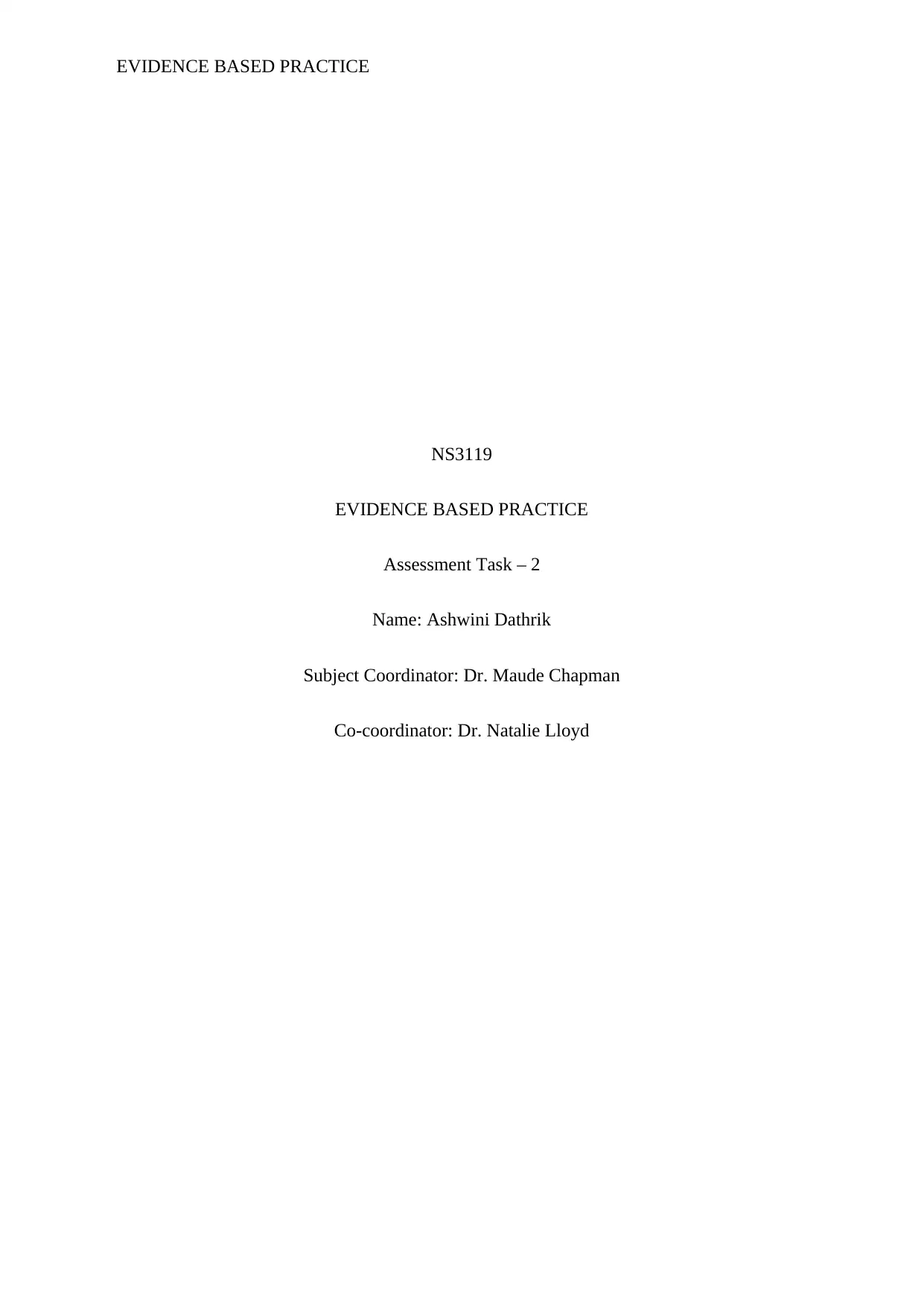
EVIDENCE BASED PRACTICE
NS3119
EVIDENCE BASED PRACTICE
Assessment Task – 2
Name: Ashwini Dathrik
Subject Coordinator: Dr. Maude Chapman
Co-coordinator: Dr. Natalie Lloyd
NS3119
EVIDENCE BASED PRACTICE
Assessment Task – 2
Name: Ashwini Dathrik
Subject Coordinator: Dr. Maude Chapman
Co-coordinator: Dr. Natalie Lloyd
Secure Best Marks with AI Grader
Need help grading? Try our AI Grader for instant feedback on your assignments.
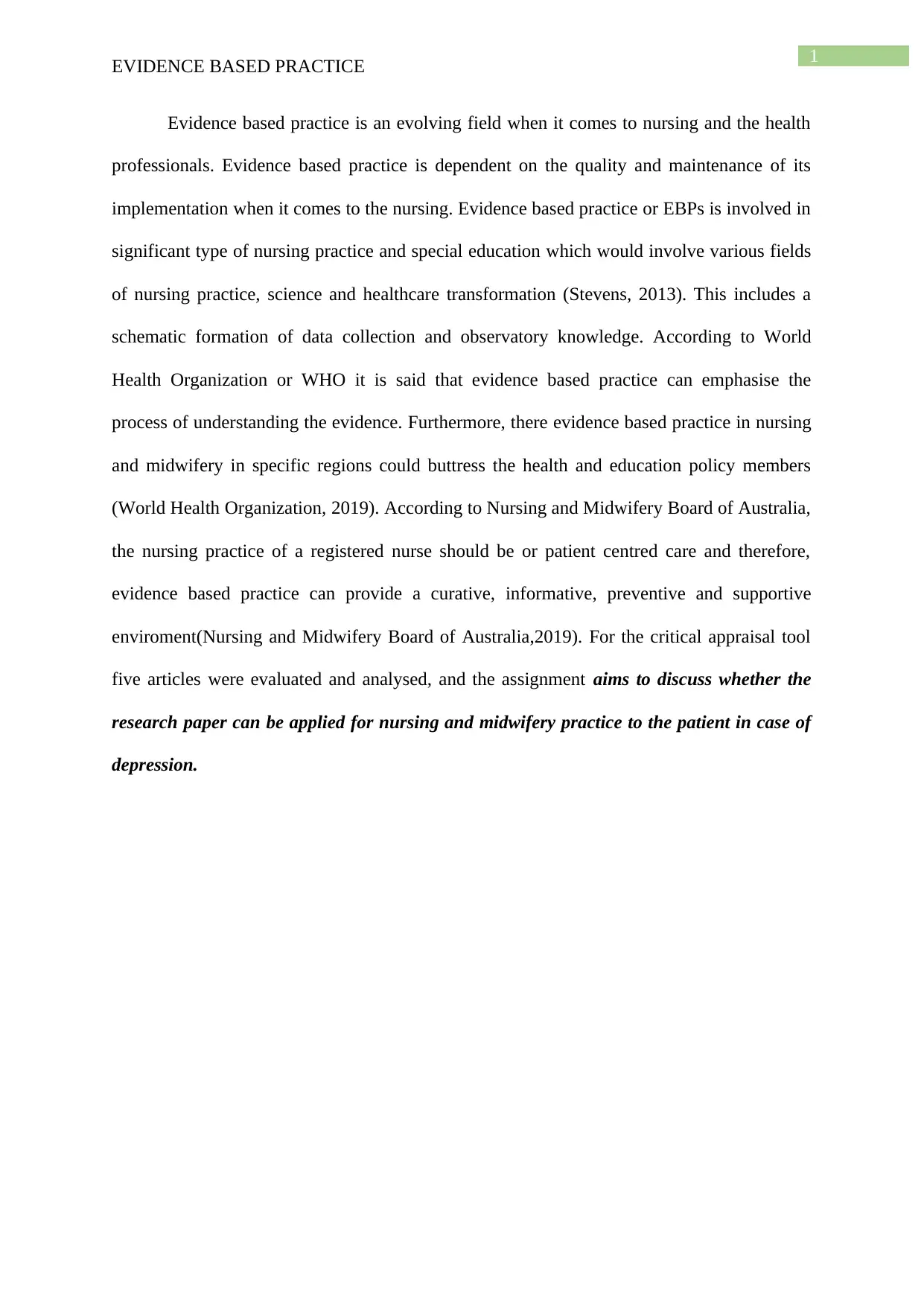
1
EVIDENCE BASED PRACTICE
Evidence based practice is an evolving field when it comes to nursing and the health
professionals. Evidence based practice is dependent on the quality and maintenance of its
implementation when it comes to the nursing. Evidence based practice or EBPs is involved in
significant type of nursing practice and special education which would involve various fields
of nursing practice, science and healthcare transformation (Stevens, 2013). This includes a
schematic formation of data collection and observatory knowledge. According to World
Health Organization or WHO it is said that evidence based practice can emphasise the
process of understanding the evidence. Furthermore, there evidence based practice in nursing
and midwifery in specific regions could buttress the health and education policy members
(World Health Organization, 2019). According to Nursing and Midwifery Board of Australia,
the nursing practice of a registered nurse should be or patient centred care and therefore,
evidence based practice can provide a curative, informative, preventive and supportive
enviroment(Nursing and Midwifery Board of Australia,2019). For the critical appraisal tool
five articles were evaluated and analysed, and the assignment aims to discuss whether the
research paper can be applied for nursing and midwifery practice to the patient in case of
depression.
EVIDENCE BASED PRACTICE
Evidence based practice is an evolving field when it comes to nursing and the health
professionals. Evidence based practice is dependent on the quality and maintenance of its
implementation when it comes to the nursing. Evidence based practice or EBPs is involved in
significant type of nursing practice and special education which would involve various fields
of nursing practice, science and healthcare transformation (Stevens, 2013). This includes a
schematic formation of data collection and observatory knowledge. According to World
Health Organization or WHO it is said that evidence based practice can emphasise the
process of understanding the evidence. Furthermore, there evidence based practice in nursing
and midwifery in specific regions could buttress the health and education policy members
(World Health Organization, 2019). According to Nursing and Midwifery Board of Australia,
the nursing practice of a registered nurse should be or patient centred care and therefore,
evidence based practice can provide a curative, informative, preventive and supportive
enviroment(Nursing and Midwifery Board of Australia,2019). For the critical appraisal tool
five articles were evaluated and analysed, and the assignment aims to discuss whether the
research paper can be applied for nursing and midwifery practice to the patient in case of
depression.

2
EVIDENCE BASED PRACTICE
In nursing practice evidence based practice or (EBP) have two important tools which
are Critical Appraisal tools and reporting guidelines (Buccheri&Sharifi, 2017). Depression is
a mental health disorder in which the patient loses interest in daily activities accompanied by
sadness. This can affect both psychological as well as physiological aspect of the person. In
the first paper by Gilbody et al., (2015), the author has targeted depression which is one of
the most common reason a patient consults the general practitioners or GP and cognitive
behavioural therapy is a thriving field of brief psychoanalysis therapy for depression. Hence,
in this research parallel randomized trial was done to study the effect of computerised
Cognitive Behavioural Therapy (cCBT). This research was based on the REEACT trial or
Randomised Evaluation of the Effectiveness and Acceptability of Computerised Therapy
which was appraised by the UK technology in 2006 as a commercially develop package for
cCBT, .The computerized Cognitive Behavioural trial was conducted on the adults who had
symptoms of depression. The paper has taken account for the randomised trial for four
months, on the commercially produced cCBT programme which was “Beating the Blues” and
a free cCBT programme “MoodGYM”. Though this type of computerised cognitive
Evidence
Based
Practice
Patient based
arpporach
( Asking
questions)
Analysiing the
ositiation
Critical Appraisal
tool
Evaluation and
Implementation
EVIDENCE BASED PRACTICE
In nursing practice evidence based practice or (EBP) have two important tools which
are Critical Appraisal tools and reporting guidelines (Buccheri&Sharifi, 2017). Depression is
a mental health disorder in which the patient loses interest in daily activities accompanied by
sadness. This can affect both psychological as well as physiological aspect of the person. In
the first paper by Gilbody et al., (2015), the author has targeted depression which is one of
the most common reason a patient consults the general practitioners or GP and cognitive
behavioural therapy is a thriving field of brief psychoanalysis therapy for depression. Hence,
in this research parallel randomized trial was done to study the effect of computerised
Cognitive Behavioural Therapy (cCBT). This research was based on the REEACT trial or
Randomised Evaluation of the Effectiveness and Acceptability of Computerised Therapy
which was appraised by the UK technology in 2006 as a commercially develop package for
cCBT, .The computerized Cognitive Behavioural trial was conducted on the adults who had
symptoms of depression. The paper has taken account for the randomised trial for four
months, on the commercially produced cCBT programme which was “Beating the Blues” and
a free cCBT programme “MoodGYM”. Though this type of computerised cognitive
Evidence
Based
Practice
Patient based
arpporach
( Asking
questions)
Analysiing the
ositiation
Critical Appraisal
tool
Evaluation and
Implementation

3
EVIDENCE BASED PRACTICE
behavioural therapy is a new field than the conventional GP care, the study limitation proved
that there was 24% drop of participants from the program and it was not as effective as the
usual GP care. The following results were found (odds ratio 1.19 (95% confidence interval
0.75 to 1.88) for Beating the Blues v usual GP care; 0.98 (0.62 to 1.56) for
MoodGYM v usual GP care). This research study is evidence to present nursing practice that
the computerized cognitive behavioural therapy is not superior to the GP care and hence, a
person fighting with depression should consult a general practitioner.
In the second paper, the primary aim was to understand the effectiveness of three
interventions in case of depression, was which was researched by Hallegran et al., (2015).
The three interventions were: physical exercise, internet based cognitive behavioural
therapy or ICBT and Treatment as usual or TAU. The secondary aim of the study was to
understand the changes in self-related work capacity. The study consisted of the total of 946
patients who had the symptoms from mild to moderate depression. The study duration was
about three months and the study design was RCT or Random Control Trial for the relative
comparison of exercise, ICBT and TAU. The patients were recruited on the basis of Patient
Health Questionnaire above 9 (PHQ-9) and were above 18 years old. The sample size was
sufficient to address the trial, where women were 73%. The exclusion criteria was based on
the age (<18), suffering somatic illness or subjected to the drug abuse. The study showed that
physical exercise and ICBT is more effective than the TAU. From the literature survey of the
research paper there were papers which indicated that TAU was not an effective treatment.
There are numerous evidences about the effect of exercise’s influence on the mental and
development, the research paper confirms the effect of exercise on mild to moderate
depression induced patient. There are numerous strengths in this paper and this can be
brought up in to the nursing and midwifery practice and the physical exercise and ICBT can
be advised to the patient with mild to moderate depression with response rate of 78%.
EVIDENCE BASED PRACTICE
behavioural therapy is a new field than the conventional GP care, the study limitation proved
that there was 24% drop of participants from the program and it was not as effective as the
usual GP care. The following results were found (odds ratio 1.19 (95% confidence interval
0.75 to 1.88) for Beating the Blues v usual GP care; 0.98 (0.62 to 1.56) for
MoodGYM v usual GP care). This research study is evidence to present nursing practice that
the computerized cognitive behavioural therapy is not superior to the GP care and hence, a
person fighting with depression should consult a general practitioner.
In the second paper, the primary aim was to understand the effectiveness of three
interventions in case of depression, was which was researched by Hallegran et al., (2015).
The three interventions were: physical exercise, internet based cognitive behavioural
therapy or ICBT and Treatment as usual or TAU. The secondary aim of the study was to
understand the changes in self-related work capacity. The study consisted of the total of 946
patients who had the symptoms from mild to moderate depression. The study duration was
about three months and the study design was RCT or Random Control Trial for the relative
comparison of exercise, ICBT and TAU. The patients were recruited on the basis of Patient
Health Questionnaire above 9 (PHQ-9) and were above 18 years old. The sample size was
sufficient to address the trial, where women were 73%. The exclusion criteria was based on
the age (<18), suffering somatic illness or subjected to the drug abuse. The study showed that
physical exercise and ICBT is more effective than the TAU. From the literature survey of the
research paper there were papers which indicated that TAU was not an effective treatment.
There are numerous evidences about the effect of exercise’s influence on the mental and
development, the research paper confirms the effect of exercise on mild to moderate
depression induced patient. There are numerous strengths in this paper and this can be
brought up in to the nursing and midwifery practice and the physical exercise and ICBT can
be advised to the patient with mild to moderate depression with response rate of 78%.
Secure Best Marks with AI Grader
Need help grading? Try our AI Grader for instant feedback on your assignments.
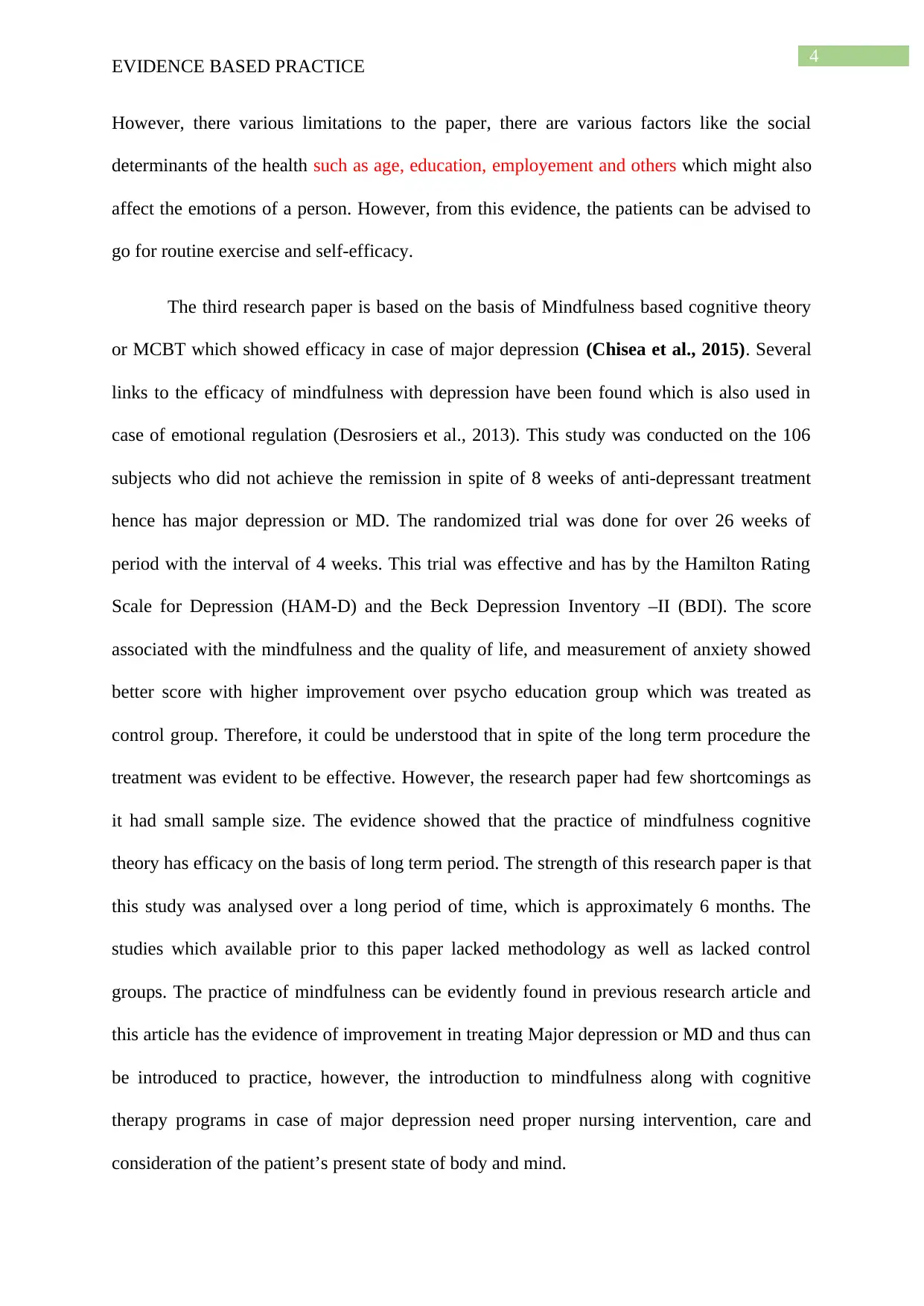
4
EVIDENCE BASED PRACTICE
However, there various limitations to the paper, there are various factors like the social
determinants of the health such as age, education, employement and others which might also
affect the emotions of a person. However, from this evidence, the patients can be advised to
go for routine exercise and self-efficacy.
The third research paper is based on the basis of Mindfulness based cognitive theory
or MCBT which showed efficacy in case of major depression (Chisea et al., 2015). Several
links to the efficacy of mindfulness with depression have been found which is also used in
case of emotional regulation (Desrosiers et al., 2013). This study was conducted on the 106
subjects who did not achieve the remission in spite of 8 weeks of anti-depressant treatment
hence has major depression or MD. The randomized trial was done for over 26 weeks of
period with the interval of 4 weeks. This trial was effective and has by the Hamilton Rating
Scale for Depression (HAM-D) and the Beck Depression Inventory –II (BDI). The score
associated with the mindfulness and the quality of life, and measurement of anxiety showed
better score with higher improvement over psycho education group which was treated as
control group. Therefore, it could be understood that in spite of the long term procedure the
treatment was evident to be effective. However, the research paper had few shortcomings as
it had small sample size. The evidence showed that the practice of mindfulness cognitive
theory has efficacy on the basis of long term period. The strength of this research paper is that
this study was analysed over a long period of time, which is approximately 6 months. The
studies which available prior to this paper lacked methodology as well as lacked control
groups. The practice of mindfulness can be evidently found in previous research article and
this article has the evidence of improvement in treating Major depression or MD and thus can
be introduced to practice, however, the introduction to mindfulness along with cognitive
therapy programs in case of major depression need proper nursing intervention, care and
consideration of the patient’s present state of body and mind.
EVIDENCE BASED PRACTICE
However, there various limitations to the paper, there are various factors like the social
determinants of the health such as age, education, employement and others which might also
affect the emotions of a person. However, from this evidence, the patients can be advised to
go for routine exercise and self-efficacy.
The third research paper is based on the basis of Mindfulness based cognitive theory
or MCBT which showed efficacy in case of major depression (Chisea et al., 2015). Several
links to the efficacy of mindfulness with depression have been found which is also used in
case of emotional regulation (Desrosiers et al., 2013). This study was conducted on the 106
subjects who did not achieve the remission in spite of 8 weeks of anti-depressant treatment
hence has major depression or MD. The randomized trial was done for over 26 weeks of
period with the interval of 4 weeks. This trial was effective and has by the Hamilton Rating
Scale for Depression (HAM-D) and the Beck Depression Inventory –II (BDI). The score
associated with the mindfulness and the quality of life, and measurement of anxiety showed
better score with higher improvement over psycho education group which was treated as
control group. Therefore, it could be understood that in spite of the long term procedure the
treatment was evident to be effective. However, the research paper had few shortcomings as
it had small sample size. The evidence showed that the practice of mindfulness cognitive
theory has efficacy on the basis of long term period. The strength of this research paper is that
this study was analysed over a long period of time, which is approximately 6 months. The
studies which available prior to this paper lacked methodology as well as lacked control
groups. The practice of mindfulness can be evidently found in previous research article and
this article has the evidence of improvement in treating Major depression or MD and thus can
be introduced to practice, however, the introduction to mindfulness along with cognitive
therapy programs in case of major depression need proper nursing intervention, care and
consideration of the patient’s present state of body and mind.

5
EVIDENCE BASED PRACTICE
The fourth article is based on comparison between the cognitive therapy with the anti-
depressant medication and only with antidepressant (Hollon et al., 2014). The sample size
was about 452 participants out of which 227 were randomized with cognitive therapy along
with combination of antidepressant medication or ADM. The remaining group which were
around 225 randomized participants were subjected to anti-depressant drug alone. The study
was based on the outpatients, and out 452 participants 170 participants recovered who were
given combined treatment and 148 participants recovered. This research paper proved the
efficacy of combined cognitive therapy along with ADM in participants having major
depressive disorder. The strength of the paper lies on the length of therapy (which was about
42 months), given to the patients as well as the on the severity of the disease. However, the
study lacks the good sample size and there were dropouts as well which could have been
more effective in this paper. The article also mentions about the safety of this research as
there are possibility of adverse effects risk, furthermore, the research lacks the significant
interaction between the recovery rate and the severity. In addition to this research lacks cost
benefit analysis. However, the combination therapy can be introduced with patient by the
nurses and midwives in the most vigilant conditions including the follow ups.
The evidence based treatment in the area of depression is increasing day by day the
fifth article focuses on a randomized control trial or RCT (Hallgren et al., 2016). This study
has sample size of 945 adults along with multicenter, three group parallel randomized
controlled trials. The study was conducted over the period of 3 months which was post
assessment and 12 months which was taken as primary end point. The computer generated
allocation was conducted externally in 36 blocs with participants in the ratio of 1:1:1. The
research paper focuses on the increased effectiveness of exercise in case of severe depression.
The exercise as well as the internet based cognitive therapy which resulted in a response rate
of 84%. The severity of the depression reduced significantly in all three groups. The scoring
EVIDENCE BASED PRACTICE
The fourth article is based on comparison between the cognitive therapy with the anti-
depressant medication and only with antidepressant (Hollon et al., 2014). The sample size
was about 452 participants out of which 227 were randomized with cognitive therapy along
with combination of antidepressant medication or ADM. The remaining group which were
around 225 randomized participants were subjected to anti-depressant drug alone. The study
was based on the outpatients, and out 452 participants 170 participants recovered who were
given combined treatment and 148 participants recovered. This research paper proved the
efficacy of combined cognitive therapy along with ADM in participants having major
depressive disorder. The strength of the paper lies on the length of therapy (which was about
42 months), given to the patients as well as the on the severity of the disease. However, the
study lacks the good sample size and there were dropouts as well which could have been
more effective in this paper. The article also mentions about the safety of this research as
there are possibility of adverse effects risk, furthermore, the research lacks the significant
interaction between the recovery rate and the severity. In addition to this research lacks cost
benefit analysis. However, the combination therapy can be introduced with patient by the
nurses and midwives in the most vigilant conditions including the follow ups.
The evidence based treatment in the area of depression is increasing day by day the
fifth article focuses on a randomized control trial or RCT (Hallgren et al., 2016). This study
has sample size of 945 adults along with multicenter, three group parallel randomized
controlled trials. The study was conducted over the period of 3 months which was post
assessment and 12 months which was taken as primary end point. The computer generated
allocation was conducted externally in 36 blocs with participants in the ratio of 1:1:1. The
research paper focuses on the increased effectiveness of exercise in case of severe depression.
The exercise as well as the internet based cognitive therapy which resulted in a response rate
of 84%. The severity of the depression reduced significantly in all three groups. The scoring
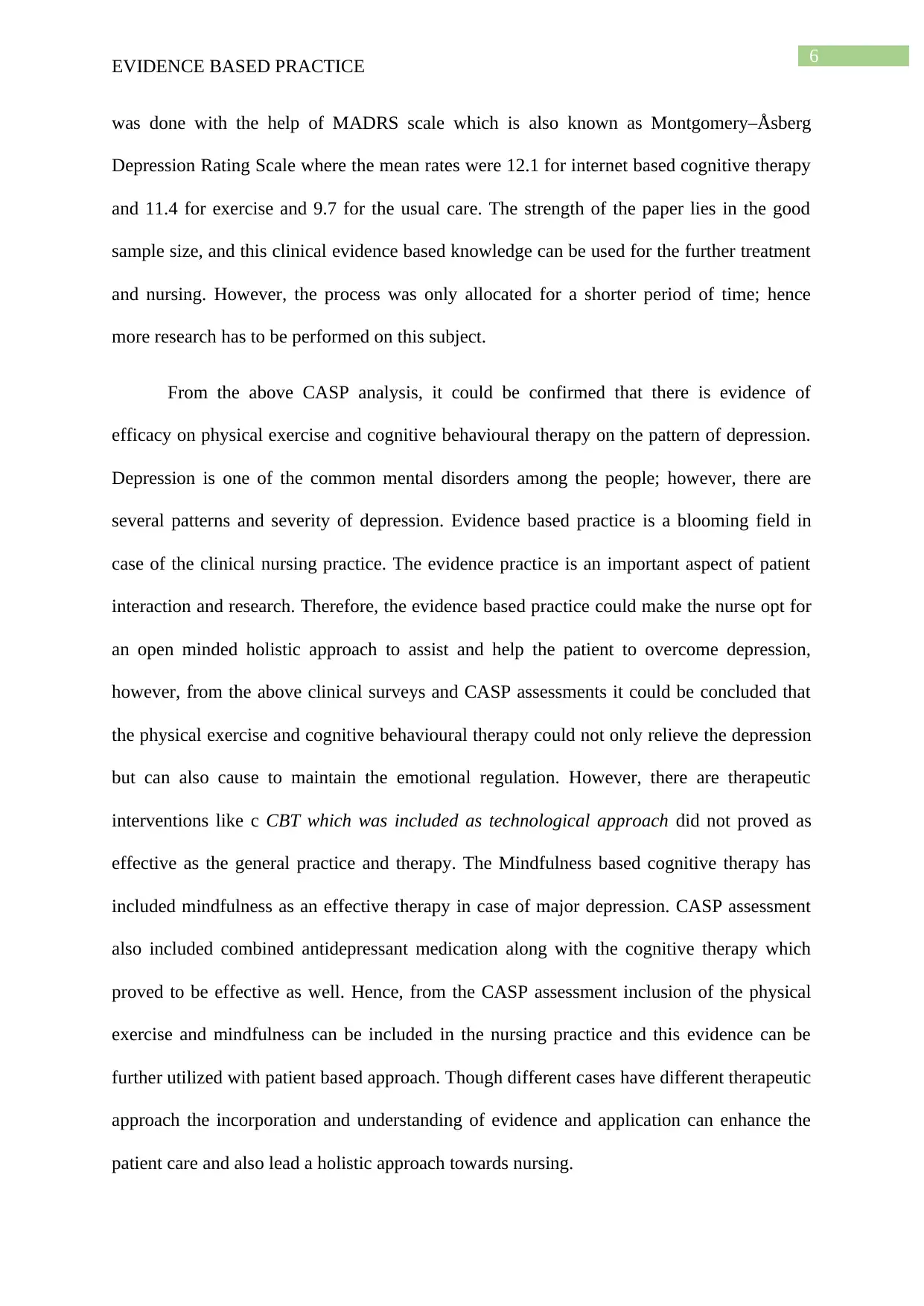
6
EVIDENCE BASED PRACTICE
was done with the help of MADRS scale which is also known as Montgomery–Åsberg
Depression Rating Scale where the mean rates were 12.1 for internet based cognitive therapy
and 11.4 for exercise and 9.7 for the usual care. The strength of the paper lies in the good
sample size, and this clinical evidence based knowledge can be used for the further treatment
and nursing. However, the process was only allocated for a shorter period of time; hence
more research has to be performed on this subject.
From the above CASP analysis, it could be confirmed that there is evidence of
efficacy on physical exercise and cognitive behavioural therapy on the pattern of depression.
Depression is one of the common mental disorders among the people; however, there are
several patterns and severity of depression. Evidence based practice is a blooming field in
case of the clinical nursing practice. The evidence practice is an important aspect of patient
interaction and research. Therefore, the evidence based practice could make the nurse opt for
an open minded holistic approach to assist and help the patient to overcome depression,
however, from the above clinical surveys and CASP assessments it could be concluded that
the physical exercise and cognitive behavioural therapy could not only relieve the depression
but can also cause to maintain the emotional regulation. However, there are therapeutic
interventions like c CBT which was included as technological approach did not proved as
effective as the general practice and therapy. The Mindfulness based cognitive therapy has
included mindfulness as an effective therapy in case of major depression. CASP assessment
also included combined antidepressant medication along with the cognitive therapy which
proved to be effective as well. Hence, from the CASP assessment inclusion of the physical
exercise and mindfulness can be included in the nursing practice and this evidence can be
further utilized with patient based approach. Though different cases have different therapeutic
approach the incorporation and understanding of evidence and application can enhance the
patient care and also lead a holistic approach towards nursing.
EVIDENCE BASED PRACTICE
was done with the help of MADRS scale which is also known as Montgomery–Åsberg
Depression Rating Scale where the mean rates were 12.1 for internet based cognitive therapy
and 11.4 for exercise and 9.7 for the usual care. The strength of the paper lies in the good
sample size, and this clinical evidence based knowledge can be used for the further treatment
and nursing. However, the process was only allocated for a shorter period of time; hence
more research has to be performed on this subject.
From the above CASP analysis, it could be confirmed that there is evidence of
efficacy on physical exercise and cognitive behavioural therapy on the pattern of depression.
Depression is one of the common mental disorders among the people; however, there are
several patterns and severity of depression. Evidence based practice is a blooming field in
case of the clinical nursing practice. The evidence practice is an important aspect of patient
interaction and research. Therefore, the evidence based practice could make the nurse opt for
an open minded holistic approach to assist and help the patient to overcome depression,
however, from the above clinical surveys and CASP assessments it could be concluded that
the physical exercise and cognitive behavioural therapy could not only relieve the depression
but can also cause to maintain the emotional regulation. However, there are therapeutic
interventions like c CBT which was included as technological approach did not proved as
effective as the general practice and therapy. The Mindfulness based cognitive therapy has
included mindfulness as an effective therapy in case of major depression. CASP assessment
also included combined antidepressant medication along with the cognitive therapy which
proved to be effective as well. Hence, from the CASP assessment inclusion of the physical
exercise and mindfulness can be included in the nursing practice and this evidence can be
further utilized with patient based approach. Though different cases have different therapeutic
approach the incorporation and understanding of evidence and application can enhance the
patient care and also lead a holistic approach towards nursing.
Paraphrase This Document
Need a fresh take? Get an instant paraphrase of this document with our AI Paraphraser
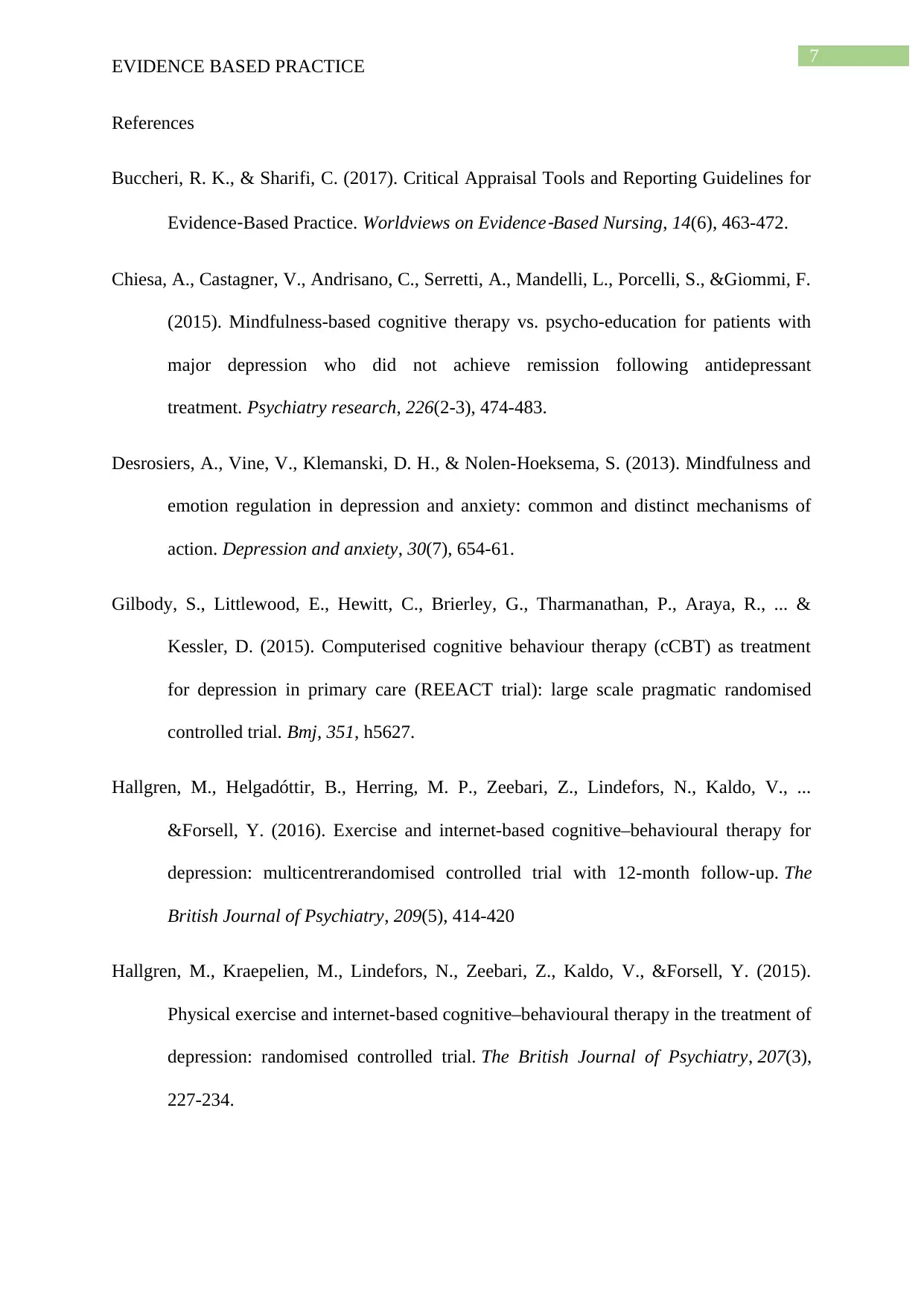
7
EVIDENCE BASED PRACTICE
References
Buccheri, R. K., & Sharifi, C. (2017). Critical Appraisal Tools and Reporting Guidelines for
Evidence‐Based Practice. Worldviews on Evidence
‐Based Nursing, 14(6), 463-472.
Chiesa, A., Castagner, V., Andrisano, C., Serretti, A., Mandelli, L., Porcelli, S., &Giommi, F.
(2015). Mindfulness-based cognitive therapy vs. psycho-education for patients with
major depression who did not achieve remission following antidepressant
treatment. Psychiatry research, 226(2-3), 474-483.
Desrosiers, A., Vine, V., Klemanski, D. H., & Nolen-Hoeksema, S. (2013). Mindfulness and
emotion regulation in depression and anxiety: common and distinct mechanisms of
action. Depression and anxiety, 30(7), 654-61.
Gilbody, S., Littlewood, E., Hewitt, C., Brierley, G., Tharmanathan, P., Araya, R., ... &
Kessler, D. (2015). Computerised cognitive behaviour therapy (cCBT) as treatment
for depression in primary care (REEACT trial): large scale pragmatic randomised
controlled trial. Bmj, 351, h5627.
Hallgren, M., Helgadóttir, B., Herring, M. P., Zeebari, Z., Lindefors, N., Kaldo, V., ...
&Forsell, Y. (2016). Exercise and internet-based cognitive–behavioural therapy for
depression: multicentrerandomised controlled trial with 12-month follow-up. The
British Journal of Psychiatry, 209(5), 414-420
Hallgren, M., Kraepelien, M., Lindefors, N., Zeebari, Z., Kaldo, V., &Forsell, Y. (2015).
Physical exercise and internet-based cognitive–behavioural therapy in the treatment of
depression: randomised controlled trial. The British Journal of Psychiatry, 207(3),
227-234.
EVIDENCE BASED PRACTICE
References
Buccheri, R. K., & Sharifi, C. (2017). Critical Appraisal Tools and Reporting Guidelines for
Evidence‐Based Practice. Worldviews on Evidence
‐Based Nursing, 14(6), 463-472.
Chiesa, A., Castagner, V., Andrisano, C., Serretti, A., Mandelli, L., Porcelli, S., &Giommi, F.
(2015). Mindfulness-based cognitive therapy vs. psycho-education for patients with
major depression who did not achieve remission following antidepressant
treatment. Psychiatry research, 226(2-3), 474-483.
Desrosiers, A., Vine, V., Klemanski, D. H., & Nolen-Hoeksema, S. (2013). Mindfulness and
emotion regulation in depression and anxiety: common and distinct mechanisms of
action. Depression and anxiety, 30(7), 654-61.
Gilbody, S., Littlewood, E., Hewitt, C., Brierley, G., Tharmanathan, P., Araya, R., ... &
Kessler, D. (2015). Computerised cognitive behaviour therapy (cCBT) as treatment
for depression in primary care (REEACT trial): large scale pragmatic randomised
controlled trial. Bmj, 351, h5627.
Hallgren, M., Helgadóttir, B., Herring, M. P., Zeebari, Z., Lindefors, N., Kaldo, V., ...
&Forsell, Y. (2016). Exercise and internet-based cognitive–behavioural therapy for
depression: multicentrerandomised controlled trial with 12-month follow-up. The
British Journal of Psychiatry, 209(5), 414-420
Hallgren, M., Kraepelien, M., Lindefors, N., Zeebari, Z., Kaldo, V., &Forsell, Y. (2015).
Physical exercise and internet-based cognitive–behavioural therapy in the treatment of
depression: randomised controlled trial. The British Journal of Psychiatry, 207(3),
227-234.
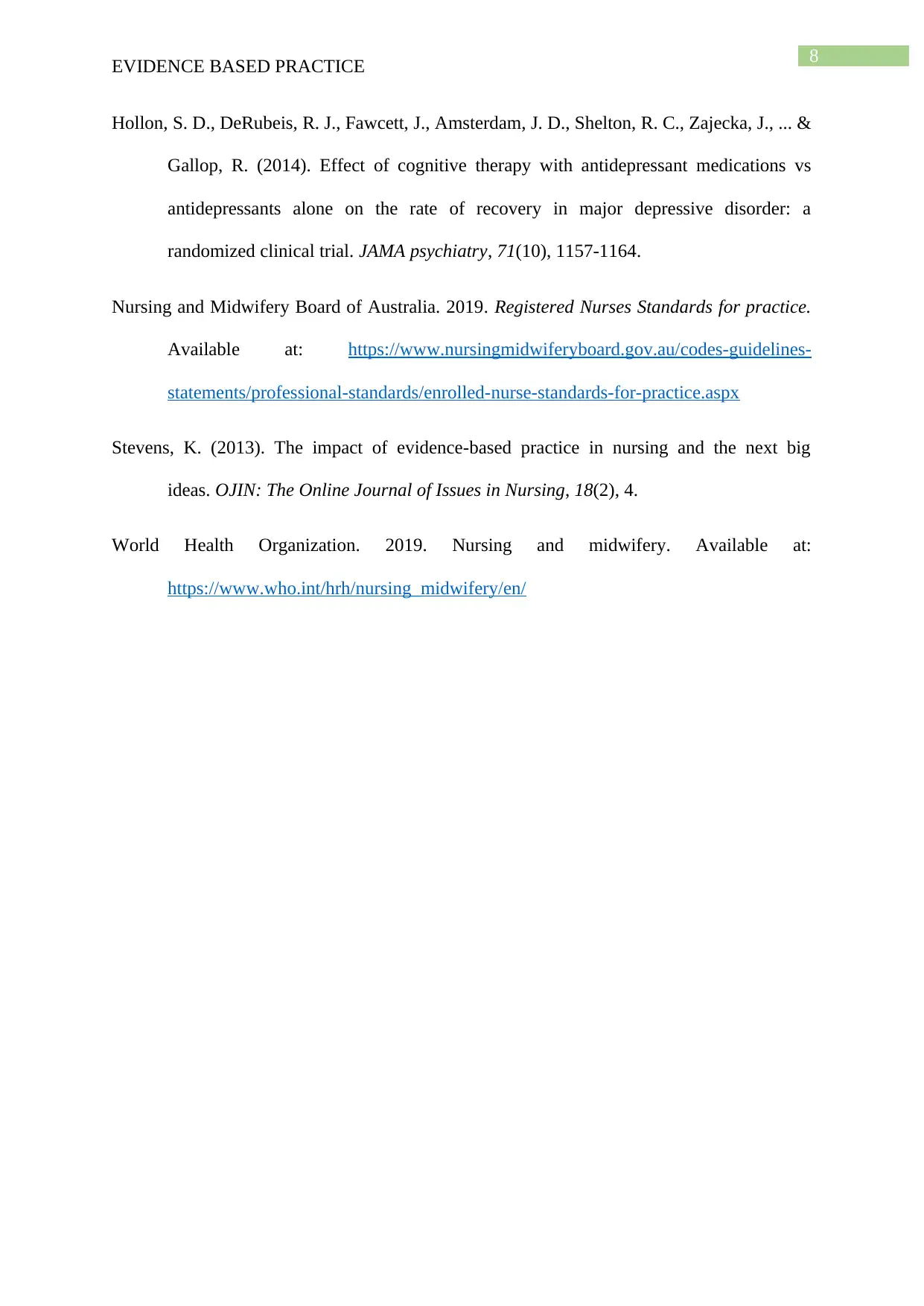
8
EVIDENCE BASED PRACTICE
Hollon, S. D., DeRubeis, R. J., Fawcett, J., Amsterdam, J. D., Shelton, R. C., Zajecka, J., ... &
Gallop, R. (2014). Effect of cognitive therapy with antidepressant medications vs
antidepressants alone on the rate of recovery in major depressive disorder: a
randomized clinical trial. JAMA psychiatry, 71(10), 1157-1164.
Nursing and Midwifery Board of Australia. 2019. Registered Nurses Standards for practice.
Available at: https://www.nursingmidwiferyboard.gov.au/codes-guidelines-
statements/professional-standards/enrolled-nurse-standards-for-practice.aspx
Stevens, K. (2013). The impact of evidence-based practice in nursing and the next big
ideas. OJIN: The Online Journal of Issues in Nursing, 18(2), 4.
World Health Organization. 2019. Nursing and midwifery. Available at:
https://www.who.int/hrh/nursing_midwifery/en/
EVIDENCE BASED PRACTICE
Hollon, S. D., DeRubeis, R. J., Fawcett, J., Amsterdam, J. D., Shelton, R. C., Zajecka, J., ... &
Gallop, R. (2014). Effect of cognitive therapy with antidepressant medications vs
antidepressants alone on the rate of recovery in major depressive disorder: a
randomized clinical trial. JAMA psychiatry, 71(10), 1157-1164.
Nursing and Midwifery Board of Australia. 2019. Registered Nurses Standards for practice.
Available at: https://www.nursingmidwiferyboard.gov.au/codes-guidelines-
statements/professional-standards/enrolled-nurse-standards-for-practice.aspx
Stevens, K. (2013). The impact of evidence-based practice in nursing and the next big
ideas. OJIN: The Online Journal of Issues in Nursing, 18(2), 4.
World Health Organization. 2019. Nursing and midwifery. Available at:
https://www.who.int/hrh/nursing_midwifery/en/
1 out of 9
Related Documents
Your All-in-One AI-Powered Toolkit for Academic Success.
+13062052269
info@desklib.com
Available 24*7 on WhatsApp / Email
![[object Object]](/_next/static/media/star-bottom.7253800d.svg)
Unlock your academic potential
© 2024 | Zucol Services PVT LTD | All rights reserved.




